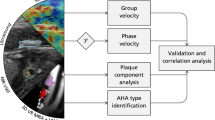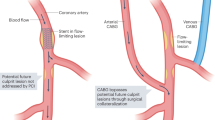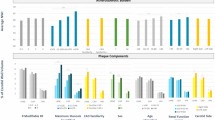Abstract
Atherothrombosis is a systemic disease of the arterial wall that affects the carotid, coronary, and peripheral vascular beds, and the aorta. This condition is associated with complications such as stroke, myocardial infarction, and peripheral vascular disease, which usually result from unstable atheromatous plaques. The study of atheromatous plaques can provide useful information about the natural history and progression of the disease, and aid in the selection of appropriate treatment. Plaque imaging can be crucial in achieving this goal. In this Review, we focus on the various noninvasive imaging techniques that are being used for morphological and functional assessment of carotid atheromatous plaques in the clinical setting.
Key Points
-
Atherosclerosis is a systemic inflammatory disease that interacts with thrombosis and affects various vascular beds
-
Carotid atheroma imaging can offer considerable insight into the underlying pathogenesis of the disease, help us understand the natural history of atherothrombosis, and facilitate the assessment of pharmacotherapies
-
At present, no ideal imaging technique exists for the assessment of carotid plaque, as each modality has benefits and limitations; however, MRI and nuclear imaging seem to hold considerable promise for the future
-
Advances in nanotechnology could also substantially improve carotid plaque imaging
-
Research should focus on the development of imaging techniques to predict those patients at high risk for future ischemic cerebrovascular events
This is a preview of subscription content, access via your institution
Access options
Subscribe to this journal
Receive 12 print issues and online access
$209.00 per year
only $17.42 per issue
Buy this article
- Purchase on Springer Link
- Instant access to full article PDF
Prices may be subject to local taxes which are calculated during checkout









Similar content being viewed by others
References
Bush RL et al. (2005) Natural history of cerebrovascular occlusive disease. In Mastery of Vascular and Endovascular Surgery, edn 4 197–202 (Eds Zelenock GB et al.) Philadelphia: Lippincott Williams and Wilkins
Ross R (1999) Atherosclerosis is an inflammatory disease. Am Heart J 138: S419–S420
Schönbeck U and Libby P (2001) The CD40/CD154 receptor/ligand dyad. Cell Mol Life Sci 58: 4–43
Hansson GK (2001) Immune mechanisms in atherosclerosis. Arterioscler Thromb Vasc Biol 21: 1876–1890
Libby P et al. (2002) Inflammation and atherosclerosis. Circulation 105: 1135–1143
Croce K and Libby P (2007) Intertwining of thrombosis and inflammation in atherosclerosis. Curr Opin Hematol 14: 55–61
Mach F et al. (1998) CD40 signaling in vascular cells: a key role in atherosclerosis? Atherosclerosis 137 (Suppl): S89–S95
Bayer IM et al. (2002) Experimental angiogenesis of arterial vasa vasorum. Cell Tissue Res 307: 303–313
Ribatti D et al. (2008) Inflammatory angiogenesis in atherogenesis—a double-edged sword. Ann Med 40: 606–621
Libby P (2002) Inflammation in atherosclerosis. Nature 420: 868–874
Li ZY et al. (2006) How critical is fibrous cap thickness to carotid plaque stability? A flow-plaque interaction model. Stroke 37: 1195–1199
Li ZY et al. (2006) Stress analysis of carotid plaque rupture based on in vivo high resolution MRI. J Biomech 39: 2611–2622
Davies PF (1995) Flow-mediated endothelial mechanotransduction. Physiol Rev 75: 519–560
Davies PF et al. (1997) Spatial relationships in early signaling events of flow-mediated endothelial mechanotransduction. Annu Rev Physiol 59: 527–549
Reneman RS et al. (2006) Wall shear stress—an important determinant of endothelial cell function and structure—in the arterial system in vivo. Discrepancies with theory. J Vasc Res 43: 251–269
Reneman RS and Hoeks AP (2008) Wall shear stress as measured in vivo: consequences for the design of the arterial system. Med Biol Eng Comput 46: 499–507
Cheng C et al. (2007) Shear stress-induced changes in atherosclerotic plaque composition are modulated by chemokines. J Clin Invest 117: 616–626
Slager CJ et al. (2005) The role of shear stress in the generation of rupture-prone vulnerable plaques. Nat Clin Pract Cardiovasc Med 2: 401–407
Slager CJ et al. (2005) The role of shear stress in the destabilization of vulnerable plaques and related therapeutic implications. Nat Clin Pract Cardiovasc Med 2: 456–464
Huang H et al. (2001) The impact of calcification on the biomechanical stability of atherosclerotic plaques. Circulation 103: 1051–1056
Doriot PA and Dorsaz PA (2005) Estimation of the axial wall strains induced by an arterial stenosis at peak flow. Med Phys 32: 360–368
Li ZY and Gillard JH (2008) Plaque rupture: plaque stress, shear stress, and pressure drop. J Am Coll Cardiol 52: 1106–1107
Spagnoli LG et al. (2004) Extracranial thrombotically active carotid plaque as a risk factor for ischemic stroke. JAMA 292: 1845–1852
Altaf N et al. (2007) Carotid intraplaque hemorrhage predicts recurrent symptoms in patients with high-grade carotid stenosis. Stroke 38: 1633–1635
Altaf N et al. (2008) Detection of intraplaque hemorrhage by magnetic resonance imaging in symptomatic patients with mild to moderate carotid stenosis predicts recurrent neurological events. J Vasc Surg 47: 337–342
Takaya N et al. (2006) Association between carotid plaque characteristics and subsequent ischemic cerebrovascular events: a prospective assessment with MRI—initial results. Stroke 37: 818–823
Weinberger J et al. (1988) Morphologic and dynamic changes of atherosclerotic plaque at the carotid artery bifurcation: sequential imaging by real time B-mode ultrasonography. J Am Coll Cardiol 12: 1515–1521
Glagov S et al. (1987) Compensatory enlargement of human atherosclerotic coronary arteries. N Engl J Med 316: 1371–1375
Topol EJ and Nissen SE (1995) Our preoccupation with coronary luminology. The dissociation between clinical and angiographic findings in ischemic heart disease. Circulation 92: 2333–2342
Fuster V et al. (2005) Atherothrombosis and high-risk plaque: Part II: approaches by noninvasive computed tomographic/magnetic resonance imaging. J Am Coll Cardiol 46: 1209–1218
Fayad ZA and Fuster V (2008) Prologue: relevance of molecular imaging in clinical medicine. Nat Clin Pract Cardiovasc Med 5 (Suppl 2): S1
Saam T et al. (2007) The vulnerable, or high-risk, atherosclerotic plaque: noninvasive MR imaging for characterization and assessment. Radiology 244: 64–77
Cai JM et al. (2002) Classification of human carotid atherosclerotic lesions with in vivo multicontrast magnetic resonance imaging. Circulation 106: 1368–1373
Hatsukami TS et al. (2000) Visualization of fibrous cap thickness and rupture in human atherosclerotic carotid plaque in vivo with high-resolution magnetic resonance imaging. Circulation 102: 959–964
Sanz J and Fayad ZA (2008) Imaging of atherosclerotic cardiovascular disease. Nature 451: 953–957
Rudd JH and Fayad ZA (2008) Imaging atherosclerotic plaque inflammation. Nat Clin Pract Cardiovasc Med 5 (Suppl 2): S11–S17
Trivedi RA et al. (2004) MRI-derived measurements of fibrous-cap and lipid-core thickness: the potential for identifying vulnerable carotid plaques in vivo. Neuroradiology 46: 738–743
Moody AR et al. (1999) Direct magnetic resonance imaging of carotid artery thrombus in acute stroke. Lancet 353: 122–123
Chu B et al. (2004) Hemorrhage in the atherosclerotic plaque: a high-resolution MRI study. Stroke 35: 1079–1084
Rothwell PM et al. (2007) Effect of urgent treatment of transient ischaemic attack and minor stroke on early recurrent stroke (EXPRESS study): a prospective population-based sequential comparison. Lancet 370: 1432–1442
Toussaint JF et al. (1997) Water diffusion properties of human atherosclerosis and thrombosis measured by pulse field gradient nuclear magnetic resonance. Arterioscler Thromb Vasc Biol 17: 542–546
Qiao Y et al. (2007) Identification of atherosclerotic lipid deposits by diffusion-weighted imaging. Arterioscler Thromb Vasc Biol 27: 1440–1446
Redgrave JN et al. (2008) Critical cap thickness and rupture in symptomatic carotid plaques: the oxford plaque study. Stroke 39: 1722–1729
von zur Muhlen C et al. (2008) Magnetic resonance imaging contrast agent targeted toward activated platelets allows in vivo detection of thrombosis and monitoring of thrombolysis. Circulation 118: 258–267
Wasserman BA et al. (2002) Carotid artery atherosclerosis: in vivo morphologic characterization with gadolinium-enhanced double-oblique MR imaging initial results. Radiology 223: 566–573
Cai J et al. (2005) In vivo quantitative measurement of intact fibrous cap and lipid-rich necrotic core size in atherosclerotic carotid plaque: comparison of high-resolution, contrast-enhanced magnetic resonance imaging and histology. Circulation 112: 3437–3444
Kerwin W et al. (2003) Quantitative magnetic resonance imaging analysis of neovasculature volume in carotid atherosclerotic plaque. Circulation 107: 851–856
Kerwin WS et al. (2006) Inflammation in carotid atherosclerotic plaque: a dynamic contrast-enhanced MR imaging study. Radiology 241: 459–468
Grobner T (2006) Gadolinium—a specific trigger for the development of nephrogenic fibrosing dermopathy and nephrogenic systemic fibrosis? Nephrol Dial Transplant 21: 1104–1108
Kimura J et al. (2005) Human comparative study of zinc and copper excretion via urine after administration of magnetic resonance imaging contrast agents. Radiat Med 23: 322–326
Dawson P (2008) Nephrogenic systemic fibrosis: possible mechanisms and imaging management strategies. J Magn Reson Imaging 28: 797–804
Agarwal R et al. (2008) Gadolinium-based contrast agents and nephrogenic systemic fibrosis: a systematic review and meta-analysis. Nephrol Dial Transplant [10.1093/ndt/gfn593]
Nagaoka K et al. (2005) Association of SIGNR1 with TLR4-MD-2 enhances signal transduction by recognition of LPS in gram-negative bacteria. Int Immunol 17: 827–836
Bonnemain B (1998) Superparamagnetic agents in magnetic resonance imaging: physicochemical characteristics and clinical applications. A review. J Drug Target 6: 167–174
Di Marco M et al. (2007) Physicochemical characterization of ultrasmall superparamagnetic iron oxide particles (USPIO) for biomedical application as MRI contrast agents. Int J Nanomedicine 2: 609–622
Crowe LA et al. (2005) Ex vivo MR imaging of atherosclerotic rabbit aorta labelled with USPIO-enhancement of iron-loaded regions in UTE imaging. Proc Intl Soc Mag Reson Med 13: 115
Howarth SP et al. (2008) Utility of USPIO-enhanced MR imaging to identify inflammation and the fibrous cap: a comparison of symptomatic and asymptomatic individuals. Eur J Radiol [10.1016/j.ejrad.2008.01.047]
Trivedi RA et al. (2004) In vivo detection of macrophages in human carotid atheroma: temporal dependence of ultrasmall superparamagnetic particles of iron oxide-enhanced MRI. Stroke 35: 1631–1635
Tang T et al. (2006) Assessment of inflammatory burden contralateral to the symptomatic carotid stenosis using high-resolution ultrasmall, superparamagnetic iron oxide-enhanced MRI. Stroke 37: 2266–2270
Tang TY et al. (2008) Correlation of carotid atheromatous plaque inflammation with biomechanical stress: utility of USPIO enhanced MR imaging and finite element analysis. Atherosclerosis 196: 879–887
Tang TY et al. (2008) Effects of aggressive versus conventional lipid-lowering therapy by atorvastatin on inflammatory activity in human carotid atherosclerotic plaques: A prospective randomised double-blind trial with USPIO-enhanced high resolution magnetic resonance imaging. Abstract 409-6. Presented at the American College of Cardiology Scientific Sessions: 2008 March 29 to April 1, Chicago, IL, USA.
Cheng GC et al. (1993) Distribution of circumferential stress in ruptured and stable atherosclerotic lesions. A structural analysis with histopathological correlation. Circulation 87: 1179–1187
Tang D et al. (2004) 3D MRI-based multicomponent FSI models for atherosclerotic plaques. Ann Biomed Eng 32: 947–960
Morrisett J et al. (2003) Discrimination of components in atherosclerotic plaques from human carotid endarterectomy specimens by magnetic resonance imaging ex vivo. Magn Reson Imaging 21: 465–474
Estes JM et al. (1998) Noninvasive characterization of plaque morphology using helical computed tomography. J Cardiovasc Surg (Torino) 39: 527–534
Oliver TB et al. (1999) Atherosclerotic plaque at the carotid bifurcation: CT angiographic appearance with histopathologic correlation. AJNR Am J Neuroradiol 20: 897–901
Walker LJ et al. (2002) Computed tomography angiography for the evaluation of carotid atherosclerotic plaque: correlation with histopathology of endarterectomy specimens. Stroke 33: 977–981
de Weert TT et al. (2008) Assessment of atherosclerotic carotid plaque volume with multidetector computed tomography angiography. Int J Cardiovasc Imaging 24: 751–759
Hyafil F et al. (2007) Noninvasive detection of macrophages using a nanoparticulate contrast agent for computed tomography. Nat Med 13: 636–641
Matsumoto M et al. (2007) Dynamic 3D-CT angiography. AJNR Am J Neuroradiol 28: 299–304
Vallabhajosula S and Fuster V (1997) Atherosclerosis: imaging techniques and the evolving role of nuclear medicine. J Nucl Med 38: 1788–1796
Bleeker-Rovers CP et al. (2003) F-18-fluorodeoxyglucose positron emission tomography in diagnosis and follow-up of patients with different types of vasculitis. Neth J Med 61: 323–329
Meller J et al. (2003) Early diagnosis and follow-up of aortitis with [(18)F]FDG PET and MRI. Eur J Nucl Med Mol Imaging 30: 730–736
Rudd JH et al. (2002) Imaging atherosclerotic plaque inflammation with [18F]-fluorodeoxyglucose positron emission tomography. Circulation 105: 2708–2711
Davies JR et al. (2005) Identification of culprit lesions after transient ischemic attack by combined 18F fluorodeoxyglucose positron-emission tomography and high-resolution magnetic resonance imaging. Stroke 36: 2642–2647
Calcagno C et al. (2008) Detection of neovessels in atherosclerotic plaques of rabbits using dynamic contrast enhanced MRI and 18F-FDG PET. Arterioscler Thromb Vasc Biol 28: 1311–1317
Rudd JH et al. (2007) (18)Fluorodeoxyglucose positron emission tomography imaging of atherosclerotic plaque inflammation is highly reproducible: implications for atherosclerosis therapy trials. J Am Coll Cardiol 50: 892–896
Rudd JH et al. (2008) Atherosclerosis inflammation imaging with 18F-FDG PET: carotid, iliac, and femoral uptake reproducibility, quantification methods, and recommendations. J Nucl Med 49: 871–878
Tang TY et al. (2008) Combined PET-FDG and USPIO-enhanced MR imaging in patients with symptomatic moderate carotid artery stenosis. Eur J Vasc Endovasc Surg 36: 53–55
Acknowledgements
U Sadat is funded by joint clinical research training fellowship of Medical Research Council (UK) and Royal College of Surgeons of England.
Author information
Authors and Affiliations
Corresponding author
Ethics declarations
Competing interests
The authors declare no competing financial interests.
Supplementary information
Supplementary Table 1
Conventional and Modified AHA Classification of Atherosclerotic Plaque (DOC 28 kb)
Rights and permissions
About this article
Cite this article
Sadat, U., Li, ZY., Graves, M. et al. Noninvasive imaging of atheromatous carotid plaques. Nat Rev Cardiol 6, 200–209 (2009). https://doi.org/10.1038/ncpcardio1455
Received:
Accepted:
Issue Date:
DOI: https://doi.org/10.1038/ncpcardio1455
This article is cited by
-
Multimodality PET/MRI agents targeted to activated macrophages
JBIC Journal of Biological Inorganic Chemistry (2014)



